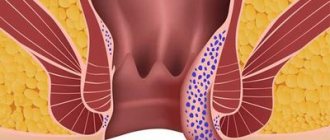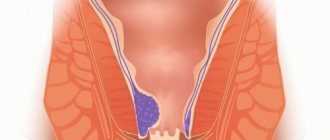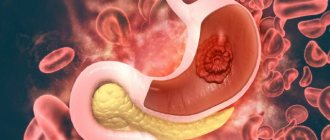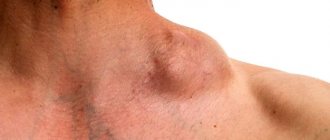“A disease of intellectual people”, “a royal disease” - hemorrhoids are called as many different names as possible. Emperor Napoleon Bonaparte, Boris Godunov, Russian Tsars Alexei Mikhailovich and Peter the Third suffered from this disease.
Currently, hemorrhoids have become especially common; both men and women are equally susceptible to it. Many people suffer from hemorrhoids, but are embarrassed to admit it to themselves, let alone see a doctor.
How to prevent the occurrence of this disease? How to choose effective remedies for hemorrhoids? How to treat hemorrhoids correctly? What methods of treating hemorrhoids are most effective today? We will answer all these questions in this article.
Hemorrhoids are a chronic progressive disease. To prevent the development of complications of hemorrhoids, you need to know the reasons for its occurrence. You can learn about this and much more from this video.
Hemorrhoids are a chronic progressive disease. To prevent the development of complications of hemorrhoids, you need to know the reasons for its occurrence. You can learn about this and much more.
Causes of late stage hemorrhoidal disease
Hemorrhoids of the 4th degree are the result of advanced pathology of the previous stages. The main reasons for this condition are untimely contact with a proctologist, ignoring his recommendations or illiterate treatment of the disease, including folk remedies, which can only be an addition to the main set of treatment measures and only in the early stages of hemorrhoidal disease.
Stages of hemorrhoidal disease, with a picture of what combined grade 4 hemorrhoids look like outside the anus
The chronic course of hemorrhoids, the transition of the pathological process to the last stage, is facilitated by:
- heavy physical work, lifting weights, strength training;
- physical inactivity, a sedentary lifestyle or prolonged, static standing;
- hereditary predisposition;
- concomitant somatic pathologies (pelvic organs, heart and blood vessels, liver, kidneys);
- pregnancy, childbirth.
A powerful negative factor in the development of hemorrhoids are bad habits: alcohol and smoking. Nicotine and ethanol negatively affect vessels deformed by chronic inflammation and blood stasis, sharply aggravating the situation, causing spontaneous complications.
Benefits of laser hemorrhoid removal
- reduced operation time;
- the operation can be performed both under general or regional anesthesia and under local perianal anesthesia;
- there is no danger of bleeding, because the laser beam coagulates all vessels;
- during the intervention process, a coagulation film is formed in the surgical area, which prevents the penetration of infection;
- laser treatment of hemorrhoids can be performed on an outpatient basis - without prolonged hospitalization;
- healing in the postoperative area occurs without the formation of rough scars;
- Relapses after laser treatment of hemorrhoids are uncommon.
Symptoms of late stage hemorrhoidal disease
At the 4th stage of hemorrhoid development, tissue atrophy occurs: blood vessels and muscles lose elasticity, so a hemorrhoidal node that falls out with any effort or careless movement cannot be set back into place even with your hands. An imbalance arises between the functionality of the muscles of the anorectal region and the size of hemorrhoidal cavities. The nodes fall out even with a slight sneeze.
Defecation is always incomplete, which provokes spontaneous feces and the release of gases.
This situation becomes a trigger for irritation and violation of the integrity of the skin of the perianal area. It is possible that a secondary infection may occur with suppuration, involving the tissues of neighboring areas in pathological inflammation. The situation can be aggravated by thrombosis, strangulation of the node up to necrosis with symptoms of intoxication, which requires emergency medical care.
Signs of fourth degree hemorrhoids are:
- constant painful spasms during bowel movements, movement, and changes in body position;
- uncontrolled bleeding from the rectum during bowel movements, leading to anemia (sometimes patients report a toilet full of blood);
- incessant itching, burning in the anorectal area;
- sensation of a foreign body in the rectum due to incomplete defecation, constantly falling out of lumps;
- increasing weakness, lethargy, headaches, dizziness, palpitations, shortness of breath during exercise.
The discomfort associated with chronic grade 4 hemorrhoids significantly reduces the patient’s quality of life and leads to loss of ability to work.
Causes of hemorrhoids
A predisposing factor to the development of the disease is impaired circulation of the venous plexuses. As a result, dystrophy develops in the muscles, connective tissue surrounding the nodes, as well as inside the anal canal. Frequent constipation or diarrhea, a sedentary lifestyle, consumption of foods containing seasonings, and alcohol contribute to the disease.
There are occupational factors, one of which is being constantly in a sitting position. Some sports – cycling, horseback riding – contribute to poor circulation. Women suffer from hemorrhoids due to frequent childbirth.
Stages of hemorrhoids
Hemorrhoids can be acute or chronic. In addition, experts spill hemorrhoids:
- interior;
- outer;
- combined.
Chronic hemorrhoids have 4 stages.
The first stage - scarlet blood is periodically released from the anus, hemorrhoids do not fall out.
The second stage - the nodes periodically fall out and are set back on their own, bleeding does not always occur.
The third stage - the nodes fall out, but they can be set on their own.
The fourth stage is characterized by the inability to independently reduce hemorrhoids.
Danger of pathology
The last stage of hemorrhoids threatens the health and even the life of the patient with its complications that require immediate treatment
- Bleeding from the hemorrhoidal cavity
: occurs due to rupture of the thinned mucous membrane of the lump with feces, tight underwear, hard surface of the stool, leads to anemia, dangerous to human life (you need to pay attention to symptoms of weakness, pale skin, shortness of breath, changes in taste sensations). - Incarceration of sunken hemorrhoidal cones
is the most common and dangerous complication of grade 4 hemorrhoids: the cause is sagging nodes through the anus, irritation of the anal muscles with their subsequent spasm, entrapment of the cavity in the anal ring (symptoms are acute pain, swelling of the anorectal area, possible thrombosis with tissue necrosis) . - Necrosis of the hemorrhoidal node
: cause - strangulation, consequence - intoxication of the body with necrosis of tissue in the anorectal area (symptoms - pain in the anus, temperature, weakness, local skin changes in the anus and nearby areas). - Anorectal thrombosis
is another of the complications of the last stage of hemorrhoids: it occurs due to inflammation in the hemorrhoids, impaired blood flow, blood viscosity, clots are formed that occupy the node, blocking its nutrition, often with tissue necrosis (symptoms - pain in the anorectal area, discoloration of the skin , swelling of the anus). - Proctitis, paraproctitis
: cause - anal fissures with secondary infection, decreased general and local immunity, there is a risk of developing sepsis, so it is extremely important to start treatment on time (symptoms - suppuration, temperature, weakness, severe pain in the anus radiating to the lower abdomen, coccyx).
Laser vaporization
Hemorrhoidal tissue can be vaporized using laser technology. To do this, proctologists at our center use an “IPG” installation with different modes of laser beam delivery. The pulsed W laser mode is most effective for vaporization of hemorrhoidal tissue. Tissues located near the impact zone practically do not heat up and are not injured. Low-traumatic and minimally invasive are the main advantages of this technique.
Very often, for stages 3-4 of hemorrhoids, laser vaporization is combined with disarterization and mucopexy. This brings the greatest effect in treatment.
The technology of disarterization with mucopexy is called HAL-RAR and is considered as a synthesis of hemorrhoidal arterial ligation and lifting of the anal canal mucosa. In any case, the treatment method must be chosen by the treating proctologist. Come to our center, and our specialists will help solve problems in a delicate area using modern treatment methods used in leading proctology centers. Outpatient treatment and issuance of a certificate of incapacity for work are important advantages for proctological patients!
More about laser vaporization
How to treat stage 4 hemorrhoids without surgery
The last stage of hemorrhoids can only be treated surgically. However, the chronic course of the process sometimes requires taking quick measures to relieve pain, acute inflammation, and stop bleeding from nodes at home.
You should always remember that this is palliative care, it is ineffective and can delay the time of contacting a proctologist until a critical moment. Starting treatment with tablets, ointments or suppositories at stage 4 of hemorrhoidal disease is strictly contraindicated. Therefore, the degree of responsibility for one’s health, in case of hope for conservative therapy, falls entirely on the shoulders of the patient.
Conservative symptomatic treatment
Symptomatic therapy for grade 4 hemorrhoids is possible:
- to relieve the severity of the pathological process, which is justified in an emergency situation: relieving a pain attack during relapse, reducing inflammation and swelling;
- when preparing a patient for surgery: since the operation cannot be performed in the acute period, a complex of medications of different groups, including antibiotics and anti-inflammatory drugs, is first used to achieve remission;
- rehabilitation period after surgery: comprehensive treatment in the postoperative period in combination with proper nutrition and special exercises will ensure the fastest recovery of the patient.
However, the doctor chooses the treatment regimen individually for each person, taking into account:
- the severity of hemorrhoids and the general condition of the patient;
- age;
- concomitant somatic diseases;
- presence of complications;
- individual drug intolerance.
The undoubted advantage of this treatment is the possibility of its use both in a hospital and at home.
Several groups of drugs are used, presented in the table.
Venotonics
Venotonics (phlebotonics) are the basis of conservative therapy for any stage of hemorrhoids. The essence of the action is to improve the tone of the veins, balance venous blood flow, and slow down the progression of the pathological process. The drugs are taken orally, used externally, but the optimal ones for advanced stages of hemorrhoids are injections of drugs intramuscularly or intravenously.
| Drug name | Cost in rubles |
| Detralex | Tablets – 640 |
| Troxevasin | Tablets – 300 Ointment – 322 |
| Phlebodia 600 | Tablets – 850 |
| Ginkor Procto | Candles – 250 Ginkor-gel – 485 |
| Witch hazel DN | Candles – 100 Witch hazel ointment – 33 Impregnated wipes – 66 |
| Procto-Glyvenol | Candles – 334 Ointment – 360 |
| Indovazin | Ointment – 243 |
What is included in the cost of hemorrhoid removal surgery?
Treatment prices depend on several factors. Fundamental among them is the specific method of surgical intervention. How much a specific operation costs can be clarified during a consultation with a doctor, who will explain the features of a particular treatment method, warn about possible complications and talk about the features of the postoperative period.
The price includes a consultation with an anesthesiologist and pain relief. Our clinic uses all modern techniques, from local anesthesia to general anesthesia.
If there are indications, other coloproctological operations can be performed in our clinic, such as:
- excision of the epithelial-coccygeal tract;
- excision of perianal fissures;
- excision of rectal fistulas;
- rectopexy (surgery for colon prolapse) and many others.
Surgical treatment of grade 4 hemorrhoids
{banner_banstat10}
The only effective way to treat late-stage hemorrhoids is surgery. Diagnosis does not cause any difficulties: grade 4 is already obvious upon visual examination. Hemorrhoidectomy in different versions or hemorrhoidopexy is used.
Contraindications
Not everyone can have the surgery. There are a number of contraindications:
- exacerbation of the pathological process, which must be relieved with conservative therapy;
- HIV infection;
- Crohn's syndrome;
- tumor processes in the body;
- pregnancy and breastfeeding;
- cirrhosis of the liver;
- individual intolerance to anesthesia.
Preparing for surgery
Before surgery, all patients undergo special training, which includes:
- clinical and laboratory examination according to the clinical minimum: KBC, OAM, biochemistry, ECG, FLG, HIV test, LUES, viral hepatitis, blood clotting, blood sugar test, coprogram, ultrasound of the abdominal organs (if necessary - sigmoidoscopy, colonoscopy, irrigoscopy) ;
- examination by a therapist;
- selection of anesthesia.
A couple of days before the operation, the patient goes on a diet that excludes all foods that irritate the intestinal mucosa and cause flatulence. Alcohol is prohibited. On the eve of the operation, they have dinner with fermented milk products, vegetable soup or salad - easily digestible food. The intestines are cleaned at night and in the morning with Fortrans. Before the operation, take a shower and put on clean underwear.
For stage 4 hemorrhoids, different types of surgical intervention are used:
- Milligan-Morgan hemorrhoidectomy;
- hemorrhoidopexy.
Milligan-Morgan hemorrhoidectomy
Classic excision of grade 4 hemorrhoids is performed in two ways: open and closed. It is used to remove external and combined hemorrhoids when the internal cavities are located near the anus.
The essence of the method is ligation of the node, clamping of the artery that feeds the cavity, subsequent excision of the hemorrhoidal formation along with the mucous membrane. The wound is not sutured using the open method; it heals by primary intention. When closed, the seams are stitched with catgut.
The operation is performed under general anesthesia, the operation is traumatic, painful, requires long-term rehabilitation (up to a month or more), often causes complications, but guarantees the absence of relapse.
Types of surgery
The option of removing internal and external hemorrhoids is associated with severe symptoms, the location and volume of inflamed lumps, and the nature of the pathology. The operation is performed to excise the affected nodes.
There are traditional and radical methods for surgically removing hemorrhoids:
- traditional: sclerotherapy, cryodestruction, use of laser, radio wave radiation, infrared coagulation, ligation, disarterization;
- radical: hemorrhoidectomy, hemorrhoidopexy.
Traditional methods
Features of the traditional method of removing hemorrhoids are the effect on inflamed nodules without the help of a surgical scalpel. The treatment method is effective in the first stages of development of the pathology, when internal varicose veins and weakness of the rectal vessels are not observed.
Minimally invasive techniques are performed without the use of anesthesia, which promotes rapid recovery of the body after the procedure.
The traditional method of removing hemorrhoids involves excision of the affected lumps with minimal damage to the inner lining of the rectum . Minimally invasive techniques are prescribed to older people, young children, and pregnant women who have restrictions on the administration of anesthesia. The operation time is no more than half an hour.
Sclerotherapy
Sclerosis is a method of surgery to remove affected hemorrhoids, which involves administering medication through an inflamed vein. The injection promotes the soldering of blood vessels, as a result of which new blood flow does not occur, therefore, the cones decrease in size.
- Rating of the best suppositories for hemorrhoids: effective and inexpensive, with descriptions, reviews and prices
This method of minimally invasive treatment is not effective in removing external hemorrhoids.
Cryodestruction
Hemorrhoids can be removed by exposing the inflamed areas to liquid nitrogen, the temperature of which reaches -200°C. Freezing the lump will help it fall off on its own within a week.
The effectiveness of the procedure lies in the effect of cold liquid nitrogen on the epithelium, due to which there is an improvement in blood microcirculation, restoration of the immune system, and metabolic processes.
Laser coagulation
Laser therapy is prescribed to remove internal and external hemorrhoids. The method promotes protein coagulation in venous vessels due to the thermal effect on the problem area.
Traditional treatment allows the arteries to stick together, which prevents blood flow to the hemorrhoids. Loss of nodules along with feces is observed 14 days after the procedure, which lasts about a quarter of an hour.
Infrared coagulation
Removal of external and internal hemorrhoids is possible using infrared rays to coagulate the protein substance in the venous vessels. The number of procedures is prescribed according to the severity of the pathology and the size of the anal cones.
The effectiveness of coagulation is determined by the prolapse of nodes and stopping of anal bleeding during defecation.
Ligation
To remove the internal shape of hemorrhoids, a ligation method is used with the insertion of round latex devices. The peculiarity of the method is bending the base of the cones to interrupt blood circulation in the veins. The fallen internal node leaves the body along with the stool 14 days after the procedure.
Lack of ligation is a temporary sensation of a foreign object in the anus.
Desarterization
For hemorrhoidal cones to die, it is necessary to block the blood supply to the venous vessels of the rectum. The disarterization method involves inserting an anoscope into the anus to determine the exact location of the artery, which is the source of fluid flow to the nodule. Through the opening of the equipment, blood vessels are cut off with medical threads. Desarterization is effective in the second or third stages of rectal disease.
- The best and most effective remedies for treating hemorrhoids
Minimally invasive methods of removal by excision of the hemorrhoidal node have negative consequences:
- pain;
- discharge of blood from the anus;
- formation of blood clots during removal of external hemorrhoids.
Pain is a recurring consequence of using traditional minimally invasive surgical treatment options for hemorrhoids. The sensitive skin of the anal epithelium becomes inflamed under the influence of latex rings or infrared radiation, causing spasms. Mild anal bleeding is observed with each removal procedure, except for laser coagulation and cryodestruction.
The negative consequence is caused by the passage of a dying hemorrhoidal nodule through the damaged area of the anus. Thrombophlebitis of clots is observed when the cones are incompletely removed when blood accumulates.
The disadvantages of using traditional methods include:
- relapse of the disease;
- cost of removal;
- lack of qualified specialists.
If there are restrictions on the implementation of minimally invasive therapy, there is no positive effect, or complications of the pathology are detected, surgical removal of hemorrhoids is prescribed.
Radical methods
Inflamed lumps should be removed in the last stages of pathology development, when the symptoms pose a threat to health.
Hemorrhoidectomy
Surgical intervention - excision of internal and external hemorrhoids of an open or closed type, which has clear advantages:
- suturing the postoperative wound of the skin after removal of hemorrhoids;
- use of local anesthesia;
- rapid recovery of the patient.
The open type of this surgical intervention involves performing the operation in a hospital ward without additional suturing of the wound, when a catheter is used for emptying. The recovery period takes more than a month for the independent healing of excised, inflamed hemorrhoidal cones and damaged mucous membranes.
There is a submucosal type of removal operation using the Parkes method. This type of intervention involves excision of only the inflamed node without removing the intestinal mucosa.
The hemorrhoidectomy operation is prescribed to remove nodes inside and outside and eliminate the cause of the first symptoms of the disease. The advantages of this type are the absence of possible relapse of the pathology.
- Absorbable ointments for lumps, nodes and blood clots in hemorrhoids
But there are downsides to surgical removal of hemorrhoids using the Milligan-Morgan method:
- duration of surgical intervention;
- copious bleeding;
- pain during the rehabilitation period;
- use of general anesthesia;
- dangerous complications after hemorrhoidectomy;
- use of potent drugs;
- long-term recovery of the body;
- restrictions on the operation:
- malignant tumors;
- Crohn's syndrome;
- gestation, postpartum period.
Hemorrhoidopexy
Inflamed hemorrhoids of the anus can be removed using the Longo method, which involves transanal resection. It is not the hemorrhoids located inside the rectum that are subject to surgical removal, but the damaged mucous membrane located above the cones.
During surgery, equipment with a visual sensor is used to identify the artery through which the venous vessels are filled with blood. After cutting off the membrane of the anal tumor, it is pulled out and dried with staples, as a result of which it falls off.
The advantages of the method of removing blood clots from hemorrhoids using the Longo method are:
- use of local anesthesia;
- absence of anal blood discharge;
- The procedure takes no more than 20 minutes;
- performing surgery at any stage of hemorrhoid development;
- minimum list of contraindications;
- absence of pain during the recovery stage;
- short rehabilitation time – no more than 7 days;
- minimal risk of possible complications, as after hemorrhoidectomy;
- no stitches or scars on the wound.
The main disadvantages of the hemorrhoid removal method are the possibility of cutting off only internal hemorrhoidal cones, as well as the high cost of the operation.
Before surgery to remove hemorrhoids, additional preparatory measures should be taken:
- visual inspection;
- instrumental diagnostics;
- laboratory tests;
- purgation.
To determine the treatment option, the surgeon examines the patient, identifies disturbing symptoms, and identifies the nature of the course and severity of hemorrhoids. After visual contact, the patient is prescribed a medical examination, including tests and instrumental diagnostics.
Preparation for a dangerous removal operation involves the collection of biological materials to determine coagulability, platelet and red blood cell levels, establish the Rh factor, and identify infectious, colds, and viral diseases. Mandatory methods of instrumental diagnostics are anoscopy and sigmoidoscopy. These methods make it possible to determine the size, location of hemorrhoids, probable complications of the pathology to determine possible risk factors and contraindications to surgical intervention.
You need to prepare for the operation in advance. Before surgery to remove hemorrhoids, you should follow a diet to normalize the functioning of the intestinal tract in order to avoid constipation, diarrhea, and increased gas formation.
If swelling, swelling, or ulcerative tumors have formed in the anal area, they should be localized as much as possible with the help of medications. Before the operation, you should cleanse the intestines with a microenema or rectal suppository, and also refrain from eating and drinking 12 hours before the procedure if general anesthesia is used, and also shave the anal area.
Can hemorrhoids be cured at stage 4?
There is no clear answer to the question. In every fifth patient, treated grade 4 hemorrhoids relapse. There is only one reason – violation of the doctor’s recommendations. It is necessary to understand that hemorrhoids of any stage require a responsible attitude towards your health until the end of your days: diet, physical activity, giving up bad habits, annual medical examination - this is the way of life of a person diagnosed with hemorrhoidal disease.
The fourth stage is no exception.
An advanced disease is more difficult to treat, using traumatic and painful methods, but hemorrhoids can be cured. Whether the hemorrhoidal node appears again depends only on the patient himself.
Possible complications
Treatment of grade 4 hemorrhoids is a difficult process that can be accompanied by complications. The most common of them:
- Painful sensations usually accompany the patient for several days after the intervention. Analgesics are administered to relieve pain.
- Bleeding often occurs after open hemorrhoidectomy. The bleeding is stopped using tampons with adrenaline.
- Sphincter insufficiency can occur if the operation is performed incorrectly.
- Acute urinary retention is in most cases a male problem. Some patients are indicated for bladder catheterization.
- Narrowing of the anal canal is a complication that can develop after closed hemorrhoidectomy if the edges of the wound are improperly sutured. In this case, special expanders are used, and if the method does not work, additional plastic surgery is performed.
- Psychological problems often arise from fear of defecation. Hemorrhoids take a long time to develop, and after removal of the nodes, the patient associates bowel movements with painful sensations. It is recommended that such patients undergo enemas.
To protect yourself as much as possible from postoperative complications, it is better to seek medical help not in the last stages, but when the first symptoms of hemorrhoids appear. If the disease is advanced, you should choose only proven institutions with high-quality equipment, focusing on the qualifications and work experience of the surgeon.










